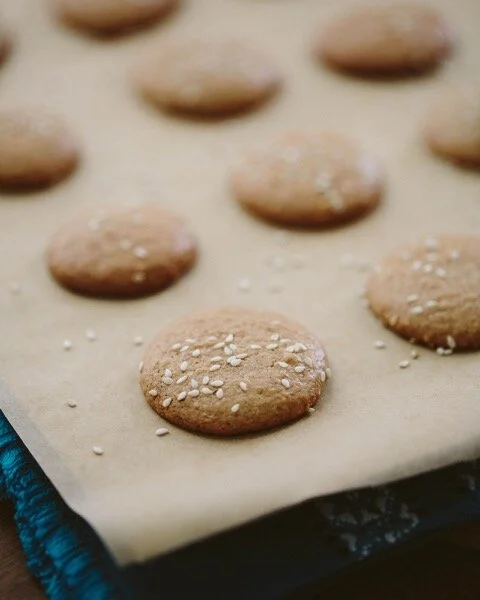AHC Alumni Spring 2021 Cohort
Golden Milk Recipe
Golden Milk: The Autumn Elixir
Golden milk is a delicious way to balance the transition into Autumn. This simple blend of spices and ghee in milk will help to warm and ground during the crisp, cool season of the Air & Ether elements. These elements become more prominently expressed this time of year, also known as Vata season!
The Vata season's signature is one of mobility, you might think of this as flighty and phrenetic energy that comes with the cooler temperature and the increase in wind, especially through leafless trees.
The season of mobility subtly impacts the body and creates more restlessness, and nervous or anxious tendencies, if not properly managed. The best way to balance mobility is with opposite qualities; stability and grounding.
Milk, whether it’s cow or almond, contains sweet and heavier qualities which help to facilitate the grounding and building qualities that Vata needs to stay balanced.
The main powerhouse of this elixir is turmeric, which gives the milk its beautiful golden color. Turmeric is high in antioxidants and has incredible anti-inflammatory and immune-boosting properties. As a rhizome (root) that grows in the ground, there are subtle grounding qualities to turmeric as well.
Immunity in Ayurveda can be loosely translated to Ojas, the immune and vitality essence of the body. The combination of milk, ghee, and turmeric boosts our Ojas, meaning it adds to our immunity reserves. The remaining spices in this recipe help to enhance digestion.
Try this recipe to start your day or end your day, as it is especially helpful to promote good sleep.
Recipe
1 cup milk, almond or cow
1 tbsp coconut sugar
1 tsp ghee or coconut oil
1/2 tsp turmeric
1/8 tsp cinnamon
1/8 tsp cardamom
A pinch of ginger powder
A pinch of nutmeg
Combine ingredients into a small saucepan over medium heat, stirring when necessary. Bring to a light boil and then remove from heat. Let cool and serve.
Ayurvedic Post-Workout Tips
Ayurvedic Post-Workout Tips
Keeping the body in balance is a daily practice. Exercise is important to maintaining balance in the mind and body, but the act itself can create imbalance without proper post-workout care. Vata Dosha is ruled by the air and ether elements and is responsible for all bodily movements and nervous and circulatory system impulses. Therefore you can expect Vata Dosha to be provoked after a workout. In the body, this can create a sense of instability, sleep disruptions, indigestion, and anxiousness.
Exercise activates the sympathetic nervous system, which increases heart rate, breathing rate, blood pressure, and circulation to the limbs. Our bodies evolved to be able to handle these physiological changes for short bouts of time. This is why it is crucial to have a post-workout routine to rejuvenate and bring the body back into the parasympathetic state of rest & digest. There is an entire branch of Ayurveda dedicated to Rejuvenation. We are pretty serious about the act of replenishment.
Here are five tips for you to give your body what it needs after a workout or yoga practice:
Warm Water with Lime & a Pinch of Raw Sugar
Your body has used a lot of electrolytes throughout your workout to help stimulate the muscles and releasing heat in the body through perspiration. Dehydration and depleted muscles equals pain. The combination of lime and raw sugar will help to stabilize blood sugar and rehydrate electrolytes.
Apply Warm Oil to Your Body
Abhyanga (oil massage) is recommended for just about everything in Ayurveda. It’s that powerful. The best way to rub out sore muscles and stimulate the lymphatic system for proper elimination of waste is to rub your body with warm oil. For a more cooling sensation use coconut oil. For a neutral effect, you can use sesame oil. This practice helps to ground down and remind the body that it’s safe to rest.
Wash with Neem & Aloe Soap
This cooling and soothing soap is a great option to cleanse with after a sweat session. Our friends at Banyan Botanicals have a great bar that is gentle enough for all skin types for every day use.
Transition Slowly
When you jump from one activity to the next, Vata stays aggravated. Try a meditation practice post-workout to calm the mind. You can even try a cooling breath work practice, as demonstrated by Sara Bravo from our sister school, Down Under School of Yoga. Or just simply lie down in Corpse pose (Savasana) for 10 minutes.
Nourish Properly
During a workout, the energy and awareness in the body is directed towards the extremities and away from the gut. Ayurveda puts extreme importance to the state of the Agni, the digestive fire. Agni is a concept that lives in the entire body, but our largest, most important Agni is found in the gastrointestinal tract. The digestive fires in the muscular, nervous, and blood tissues take over during a workout, taking the awareness away from the digestion of food. Therefore it is not recommended to dive right into a meal afterwards. Taking a moment to prime the body back into parasympathetic mode (rest & digest) is key to digesting and assimilating nutrients to refuel properly. Choose a meal that is warm, nutrient-dense, and balanced in carbs, fats and proteins with digestive spices such as cumin, coriander, and fennel to end your post-workout routine.
As with anything Ayurveda, it’s always best to work with your own unique body constitution that Ayurveda breaks up by elements and qualities. Our Personalized Ayurveda Immersion is a self-paced online program which shows you how to weave these principles into your own life. You will get assigned a coach to help answer your questions and guide you along. Join us in a deep self-discovery into this ancient Vedic science.
Our Top Tea Blends for September
Ojas-building Rice Pudding
Recipe: 20-min Spiced Rice
Alumni Spotlight - Pooja Thawani
Alumni Spotlight - Samantha Devine
Welcome in Gratitude and Contentment
Seasonal Shifts: Falling into Fall with Grace and Poise (...and a Hint of Ayurveda)
Ayurvedic Choco-Coco Truffles Recipe
These Choco-Coco Truffles are full of luscious, delectable goodness and are one of Dr. Hinduja’s, Ayurveda Faculty, favorites. In the winter months, qualities opposite to the qualities of Vata such as moistness, sense of grounding, smoothness, and stabilizing are welcomed. These opposite qualities stabilize the qualities of Vata such as dryness, roughness, and lightness. Winter is also the perfect time to have foods that boost the immune system.



















